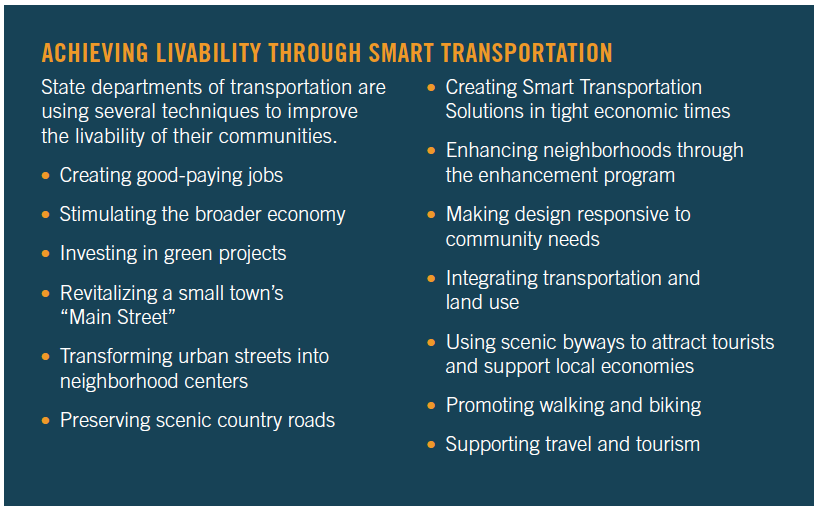AMERICAN ASSOCIATION OF STATE HIGHWAY AND TRANSPORTATION OFFICIALS
WHAT IS A LIVABLE COMMUNITY?
Soon, members of Congress will be asked to decide “What makes a ‘livable’ community?” Since the U.S. Department of Transportation is making livability a top priority for future transportation funding, this is an important concept to define. While some would suggest livability means a life without cars, this definition really doesn’t work for the millions of Americans who have chosen the lifestyle that an automobile affords.
A public policy that addresses true livability must include not only urban but rural communities, not only the environment but also the economy, not only transit riders and bicyclists, but soccer moms and family vacationers at the Grand Canyon.
The Washington State Department of Transportation suggests that a “livable future” requires a balance of three key societal goals: vibrant communities, vital economy and sustainable environment—all goals for which good transportation is essential.
In providing good transportation networks for their citizens, state DOTs have long been the incubator of such “livable” policies as community-sensitive design, historic preservation, asphalt recycling, and practical engineering. They support the expansion of choices for transportation users to include transit, walking and biking. Daily they are working with communities and demonstrating that livability can be accomplished through road-related improvements.
If enhancing livability is the objective of transportation legislation or regulation, then it must work for those who live in rural Montana just as much as it would for those in downtown Portland. Equating livability only to riding transit, walking and biking, limits its relevance and excludes a wide range of improvements and community needs.
LIVABILITY MEANS CHOICES
- Realtor Tracy Wiens uses her hybrid Toyota to drive her clients around Portland, Ore, to visit properties,
but on the weekends, she walks with her children to the nearby Mount Tabor City Park to bike. - Barb and Don Abbruzzese, recently retired and living in a suburb of Columbus, Ohio, head
out three times a week to drive down I-70, I-670 and I-315 to their Pilates class at McConnell
Heart Health Center. - In getting to her job in the Palisades neighborhood of Washington, DC, from the nearby
suburb of Upper Marlboro, Md, Leah Appel rides a car to the Metro, hops the Green and Red
lines to Dupont Circle, and then transfers to a bus—a two-hour trip each way. - In downtown Charleston, West Virginia, Sandy Fisher uses her lunch break to walk her dog,
“Mr. Mouse,” around her Capitol area neighborhood. Her bungalow is just minutes from her
job, shopping, restaurants, and a quick drive to visit her mother at a nearby nursing home.
Every transportation project is an opportunity to improve the quality of life in a community.
Each of these people live in what they believe to be “livable communities”, whether it is in the heart of a downtown, a close-in suburb or farther out in a more r ural area. And while much of the focus on livability has been about expanding the opportunities to use transit, or in making it easier to walk or bike, for many Americans these options are simply not practical in meeting their everyday needs for transportation.
Download full report (PDF): The Road to Livability
About American Association of State Highway and Transportation Officials
www.aashto.org
“The American Association of State Highway and Transportation Officials is the voice for transportation and catalyst for organizational and technical excellence…AASHTO advocates transportation-related policies and provides technical services to support states in their efforts to efficiently and safely move people and goods.”
Tags: AASHTO, American Association of State Highway and Transportation Officials, Department of Transportation, John Horseley, Livability, Ray LaHood







 RSS Feed
RSS Feed